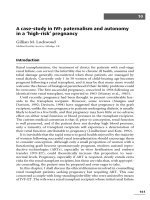Case Study: united kingdoms carbon budget
Bạn đang xem bản rút gọn của tài liệu. Xem và tải ngay bản đầy đủ của tài liệu tại đây (247.51 KB, 4 trang )
Low Carbon Green Growth Roadmap for Asia and the Pacific
CASE STUDY
Taking a leading step away from its CO2 footprint
United Kingdom’s carbon budget
Key point
•
The United Kingdom provides an innovative example of a nationally led effort to reduce CO2 emissions
through carbon budgets.
There was courage to change and to be the first…
In 2008, the UK Parliament passed legislation that introduced the world’s first long-term legally binding framework
that required at least an 80 per cent slash in greenhouse gas emissions by 2050 and 34 per cent by 2020. The law
also required the United Kingdom to establish and, as of 2009, adhere to a carbon budget – a cap on the total
quantity of greenhouse gas emissions over five-year periods, the first in the world as well. The law also set up a
Committee on Climate Change (CCC) – the first of its kind and an independent but statutory body of experts to
advise the Government on the level of carbon budgets and on where cost-effective savings could be made.
The CCC brings together expertise from the fields of climate science and policy, economics, business competitiveness and financial management.1
Under a system of carbon budgets, every tonne of greenhouse gas emitted between the start point and 2050 is
counted, and a country needs to achieve corresponding reductions in each period of time.
What was done?
In its December 2008 report, the CCC advised on the level of the first three carbon budgets for three five-year
periods. The first budget (2008–2012) set maximum net emissions at 3 billion tonnes of CO2 equivalent, a 22 per
cent reduction from the 1990 levels. The second budget (2013–2017) limits emission to 2.78 billion tonnes of CO2
equivalent, a 28 per cent reduction, and the third budget (2018–2022) restricts emissions to 2.54 billion tonnes of
CO2 equivalent, a 34 per cent cut.2 In proposing those levels, the CCC followed the European Union framework
and produced two sets of budgets: an interim budget, to apply before a second global agreement on greenhouse gas emissions (following the Kyoto Protocol) are reached, and an intended budget to apply after a global
deal is reached. Both sets of budgets are designed to apply to all greenhouse gases rather than just CO2.
The interim budget will require an annual average emissions reduction of 1.7 per cent over the first three budget
periods. The intended budget requires an emissions reduction of 42 per cent relative to 1990 and 31 per cent
relative to 2005 in 2020. This will require an annual average emissions reduction of 2.6 per cent over the first three
budget periods.3
As if that commitment was not staggering enough, in May 2011 the UK Government announced an unprecedented fourth carbon budget (2023–2027) (set in law at the end of June 2011) to halve the 1990 levels of CO2
emissions by 2027.4
1
United Kingdom, Department of Energy and Climate Change website “Climate Change Act 2008”. Available from
www.decc.gov.uk/en/content/cms/legislation/cc_act_08/cc_act_08.aspx (accessed 4 March 2012).
2
World Nuclear News, “UK Proposes Fourth Carbon Budget” (May 19 2011). Available from www.world-nuclear-news.org/EEUK_proposes_fourth_carbon_budget-1905114.html (accessed 17 November 2011).
3
Committee on Climate Change website “1st to 3rd Carbon Budgets”. Available from www.theccc.org.uk/carbon-budgets/1st-3rdcarbon-budgets-2008-2022 (accessed 21 November 2011).
4
Committee on Climate Change website “Carbon Budgets”. Available from www.theccc.org.uk/carbon-budgets (accessed 21 November 2011).
Low Carbon Green Growth Roadmap for Asia and the Pacific : Case Study - United Kingdom’s carbon budget
The UK Low Carbon Transition Plan
To achieve the challenging targets and move towards a low-carbon economy, the Government announced
the Low Carbon Transition Plan, which details emissions cuts by sector. It proposes that half of the required cuts
in emissions by 2020 will come from power and heavy industry, 20 per cent from transport, 15 per cent from
homes, 10 per cent from workplaces and 5 per cent from agriculture. It is also expected to create 1.2 million new
green jobs and provide 1.5 million households with support to produce their own renewable energy. Estimations
indicate that the entire plan will save about 715 million tonnes of CO2 and orient the United Kingdom towards
fulfilling the first three of its carbon budgets.5 The Low Carbon Transition Plan sets emission reduction targets and
defines action areas by sector:6
•
•
•
•
•
Power sector and heavy industry: The plan aims to cut emissions by 22 per cent from 2008 levels by 2020
by producing around 30 per cent of electricity from renewable sources and helping to build nuclear
power stations.
Homes: The plan aims to cut emissions by 29 per cent of the 2008 levels by investing money to help households become energy efficient, distributing smart metres and introducing clean energy cash-back
schemes.
Transport: 14 per cent of the 2008 level of emissions from domestic transport is going to be cut by
tightening emission standards for new cars and by investing money in electric and plug-in hybrid cars,
recharging infrastructure and low-carbon bus technology.
Workplaces: 13 per cent of emissions in comparison to the 2008 levels are expected to be reduced by
creating jobs in the low-carbon industry.
Farms: The plan will also look to reduce farming and waste emissions by 6 per cent of the 2008 levels.
The Carbon Plan
The Carbon Plan (December 2011) is a package of measures to ensure that the United Kingdom achieves its
emissions reduction targets in the first four carbon budgets and is securely headed towards its 2050 target. The
Carbon Plan explains “how the UK will achieve decarbonisation within the framework of [their] energy policy: to
make the transition to a low carbon economy while maintaining energy security, and minimizing costs to consumers, particularly those in poorer households.”7
The details cover specific actions by sector – such as low-carbon buildings, transport, industry, electricity, agriculture, land use, forestry and waste. With electricity generation, for instance, it touches on how to shift away from
fossil fuels to renewable, for heating of homes and buildings it explains how to better insulate and use low-carbon
energy alternatives and for road transportation, it talks of how to provide better public transport and electric
vehicles. The country’s Green Investment Bank will support innovations in green technologies for de-carbonizing
the power, buildings and road transport sectors – partly based on the belief that early investment in technological options will reduce costs for deploying technologies in 2020 and at the same time improve the competitiveness of UK industries.8
Costs and financing
The CCC estimated the cost of meeting the four carbon budgets at less than 1 per cent of its GDP and the cost
of meeting the 2050 target between 1 and 2 per cent of GDP.9 Given the relative capital intensity of low-carbon
5
United Kingdom, The UK Low Carbon Transition Plan: National Strategy for Climate and Energy (London, HM Government, 2009).
Available from
/>wcarbontransitionplan.pdf (accessed 12 March 2012).
6
Felicity Carus, "The Low Carbon Transition Plan at a Glance", The Guardian, July 15 2009. Available from
www.guardian.co.uk/environment/2009/jul/15/renewableenergy-carbon-emissions (accessed 21 November 2011).
7
United Kingdom, Carbon Plan: Executive Summary (London, Department of Energy and Climate Change, 2011). Available from
www.decc.gov.uk/assets/decc/11/tackling-climate-change/carbon-plan/3751-carbon-plan-executive-summary-dec-2011.pdf (accessed
12 March 2012).
8
United Kingdom, Carbon Plan (London, Department of Energy and Climate Change, 2011). Available from
www.decc.gov.uk/assets/decc/What%20we%20do/A%20low%20carbon%20UK/1358-the-carbon-plan.pdf (accessed 27 February 2012).
9
Committee on Climate Change website “Costs & Opportunities”. Available from www.theccc.org.uk/carbon-budgets/economics-aimpacts/costs-a-opportunities (accessed 21 November 2011).
Low Carbon Green Growth Roadmap for Asia and the Pacific : Case Study - United Kingdom’s carbon budget
technologies, the investment costs to meet carbon budgets are estimated to reach up to £16 billion annually by
2030, with £10 billion on electricity generation.10 Several programmes were set up to finance the carbon budget
scheme. An Environmental Transformation Fund and a Low Carbon Investment Fund were set up as incentives
for companies; the funds offered financial support for the research and development of low-carbon technologies and helped in commercializing.11 The Low Carbon Buildings Programme provided grants for the funding
and installation of micro-generation technologies.12 These three funding mechanisms were all closed to allocation by 2011. The Enhanced Capital Allowances, in contrast, is a tax exemption scheme allowing businesses to
claim 100 per cent first-year capital allowances on their spending on qualifying plant and machinery and is still
in place.13
Policy path leading to carbon budgets
The UK Government became an early player in the low-carbon field, making its early adoption of the carbon
budget not too much of a surprise. The following highlights three early milestones:
Renewable Transport Fuel Obligations Act: Implemented in 2008, it was designed to ensure that at least
5 per cent of all fuel used for road transportation came from renewable sources by 2010.14
Code for Sustainable Homes: Officially launched in 2006, it is a voluntary environmental impact and
sustainability rating system for residential properties, aiming for a reduction in the environmental impact
of housing and setting minimum standards for the design and construction of new homes.15
•
•
Results
British Prime Minister David Cameron noted, "The transition to a low-carbon economy is necessary, real, and
global. By stepping up, showing leadership and competing with the world, the UK can prove that there need not
be a tension between green and growth."16
Developing and implementing carbon budgets are expected to bring the United Kingdom many significant
opportunities. The global market for environmental goods and services is already lucrative, thus presenting a
great incentive for the country to become a leader in the production of low-carbon goods and services. The
Government is expecting co-benefits from policies to reduce carbon emissions, such as reduced reliance on
imported gas and oil, reduced local air pollution through low-carbon vehicles and renewable energy sources
and increased health benefits.
10
ibid.
11
United Kingdom, Department of Energy and Climate Change website “Historic Funding”. Available from
www.decc.gov.uk/en/content/cms/funding/funding_ops/innovation/historic/historic.aspx (accessed 5 March 2012).
12
United Kingdom, Department of Energy and Climate Change website “Low Carbon Buildings Programme”. Available from
www.decc.gov.uk/en/content/cms/funding/funding_ops/innovation/historic/buildings_prog/buildings_prog.aspx (accessed 12 March
2012).
13
United Kingdom, Department of Energy and Climate Change website “Enhanced Capital Allowances”. Available from
www.decc.gov.uk/en/content/cms/emissions/ecas/ecas.aspx (accessed 12 March 2012).
14
Karen Ellis, Bryn Baker and Alberto Lemma, Policies for Low Carbon Growth (London, Overseas Development Institute, 2009). Available
from www.odi.org.uk/resources/docs/5570.pdf (accessed 26 February 2012).
15
United Kingdom, Code for Sustainable Homes: A Step-Change in Sustainable Home Building Practice (London, Department for Communities and Local Government, 2006). Available from www.planningportal.gov.uk/uploads/code_for_sust_homes.pdf (12 March 2012).
16
United Kingdom, Department of Energy and Climate Change, "UK Proposes Fourth Carbon Budget", Press release, No. 11/041, May 17,
2011. Available from www.decc.gov.uk/en/content/cms/news/pn11_41/pn11_41.aspx (accessed 12 March 2012).
Low Carbon Green Growth Roadmap for Asia and the Pacific : Case Study - United Kingdom’s carbon budget
Considerations for replicating
Developing a carbon budget is a complicated process, requiring:
•
•
•
•
•
•
Legally established short-, medium- and long-term greenhouse gas emissions target and goals
Timetables for reducing emissions to achieve medium- and long-term targets
A transition plan and strategies
Specific measures and actions to reduce greenhouse gas emissions
Sector-based plans
Investment plans.









